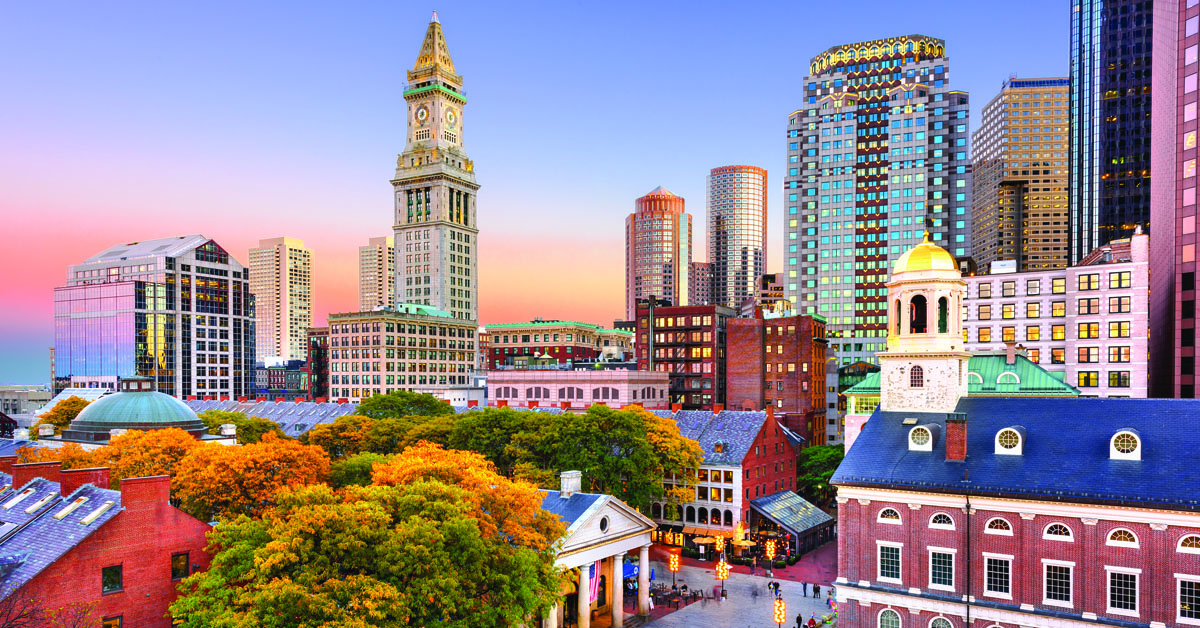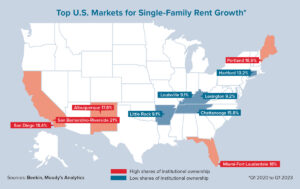New England may have the most instantly recognizable aesthetics of any U.S. region: the blazing colors of autumn, seaside towns on Cape Cod, colonial architecture, leafy Ivy League campuses and sailboats in the summer. This iconic style blends within modern cities across the region but nowhere more visibly than in Boston, where skyscrapers serve as the backdrop for historic government buildings, churches and more.
The Old State House in Boston, for example, is only three stories tall and is historically preserved as the site of the Boston Massacre. Directly behind it is One Boston Place, a 41-story office tower and one of the tallest buildings in the city. The architectural juxtaposition makes for interesting city planning and stunning photographs.
The wealth of historic buildings in New England also has made possible some creative adaptive-reuse projects. In North Adams, Massachusetts, a defunct factory was turned into the Massachusetts Museum of Contemporary Art. This massive project transformed a 17-acre industrial complex over the course of 25 years. According to the architects, all of the structural wood, finished wood and bricks used were salvaged from the original building.
In Boston, the Charles Street Jail was transformed into the luxe Liberty Hotel, while in Brunswick, Maine, an old schoolhouse became the Edwards Center for Art and Dance at Bowdoin College. In Auburn, Massachusetts, two former schools were adapted into senior housing. And developers have more of these types of projects underway across the region, including school and factory redevelopments into affordable apartments.

The New England Region is economically diverse, and while some states kept pace with the rest of the country, others saw dramatic declines in gross domestic product (GDP) in second-quarter 2022. The U.S. as a whole had an annualized GDP decrease of 0.6% at that time. Vermont and Maine kept relative pace, recording drops of 0.2% and 1.2%, respectively. Rhode Island was tops in the region, gaining 0.6%, and was one of only 10 states to grow its GDP in the quarter.
New Hampshire, Massachusetts and Connecticut did not fare as well. New Hampshire saw a 2.5% dip in GDP, with Massachusetts down 2.6% and Connecticut down 4.7% (the second-highest decrease in the nation). In Q3 2022, however, other economic indicators were good, with payroll employment increases and unemployment rate decreases across the region.
The number of jobs across the region increased by 2.9% from August 2021 to August 2022, with the largest gain in Massachusetts (3.6%) and the smallest in New Hampshire (1.2%). Payroll employment at that time was still below its pre-pandemic peak in every state in New England. The largest gains recorded both regionally and nationally were in the leisure and hospitality sector, and New England outpaced the U.S. average in construction jobs created.
This past August, the unemployment rate for the region was 3.4%, lower than the 3.7% figure for the nation. Each state in New England posted year-over-year decreases in unemployment, with the largest decrease in Rhode Island (down 3 percentage points during the year). Connecticut was the only state in this region to exceed the national average, with an August unemployment rate of 4.1%. ●

Boston’s industrial real estate market thrived in 2022, with the vacancy rate dropping to an all-time low of 2.4% in the third quarter, according to Cushman & Wakefield. Net absorption remained positive for the 10th consecutive quarter while year-to-date absorption rose to more than 1.5 million square feet. The market saw 5.2 million square feet of new leases signed through the first three quarters of the year, with 2 million square feet in Q3 2022 alone.
Average asking rents jumped 5.5% from the second quarter to a new all-time high of $13.19 per square foot. Cushman & Wakefield reported that job sectors such as trade, transportation and utilities were driving this growth in demand. E-commerce was a main factor as well, with online sales up 64.2% compared to Q4 2019.
Nearly 3.3 million square feet of industrial space was in the construction pipeline in the Boston metro area as of Q3 2022. Many facilities are offering modern amenities and higher clearance heights to fit the needs and requirements of modern industrial tenants. The vast majority of this construction is happening in close proximity to Interstate 495.
What the Locals Say
Boston has a very high GDP per capita. There’s a lot of opportunity here: We’re creating more jobs than we are housing units, which is good for real estate. It has a pretty liquid market in terms of being able to sell properties but also in terms of financing and investment dollars available.
The highest-growth area in Boston has been life sciences, so the lab sector was the hottest for a while. That has begun to cool with a bit of an oversupply. Tourism has come back strong; there’s a shortage of hotel rooms in Boston and there’s not many hotels in the pipeline. There are a few but not enough — hotels are expensive, and in Boston, Airbnb is not tolerated for investors, which makes hotel rooms even more scarce.
Office space was affected by COVID-19, so now one of the largest trends we’re seeing in Boston is that the Financial District seems to have migrated over to the Seaport. From an office perspective, the Seaport is where it’s at now. I think, in the long term, a lot of those buildings in the Financial District might be converted to residential.
There has been a trend over the past 10 years or so of companies moving into the city, and the Seaport has generated a lot of that. There’s been a bit of a flight from suburbia back into the city, especially for companies that want to attract young people. Young people want to live in the city.
Outside of Boston, Cape Cod has been very strong, but it has begun to slow down because of the current economy. Southern New Hampshire; Portland, Maine; Worcester, Massachusetts; and Providence, Rhode Island are all hot submarkets as well, with growth in multifamily and warehouses.

Fergal Woods
Managing Partner
FinanceBoston
3 Cities to Watch
Providence

The capital and most populous city in Rhode Island sits at the mouth of the Providence River. The city is home to eight colleges and universities, along with eight hospitals. Accordingly, the metro area’s largest employment sector is education and health services, with strong employment in trade, transportation and utilities as well as leisure and hospitality. Major employers include Brown University, Lifespan Health, Care New England and CVS Health Corp. (headquartered near Providence).
Hartford

Connecticut’s capital city is full of historic attractions, with the gothic-style Connecticut State Capitol as its crown jewel. The city is the fourth largest in the state by population with roughly 120,000 people. Hartford is home to the country’s oldest public art museum, the oldest publicly funded park and the oldest continuously published newspaper. Hartford also hosts the headquarters of some of the largest insurance companies in the country, including health care giant Aetna.
Burlington

Situated along the shores of Lake Champlain, Burlington is the most populous city in Vermont. It’s a college town (home to the University of Vermont and Champlain College) and is well known as the home of Ben & Jerry’s ice cream. Burlington might be America’s most sustainable city, with the country’s first all-renewable energy sources, $1.3 million in food grown within city limits each year and plans for City Hall to become a net-zero consumer of energy within the decade.
Sources: Architecture Daily, Cambridge Seven, Cushman & Wakefield, Federal Reserve Bank of Boston, Forbes, Go Providence, Hartford Courant, Politico, Seniors Housing Business, Signature Boston





